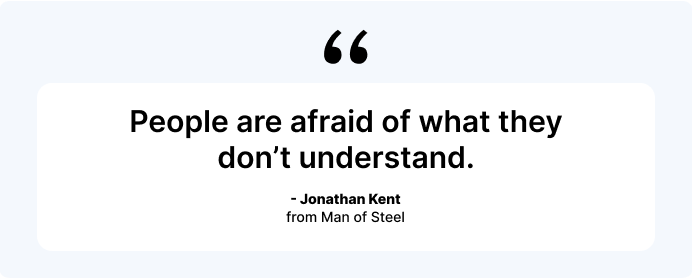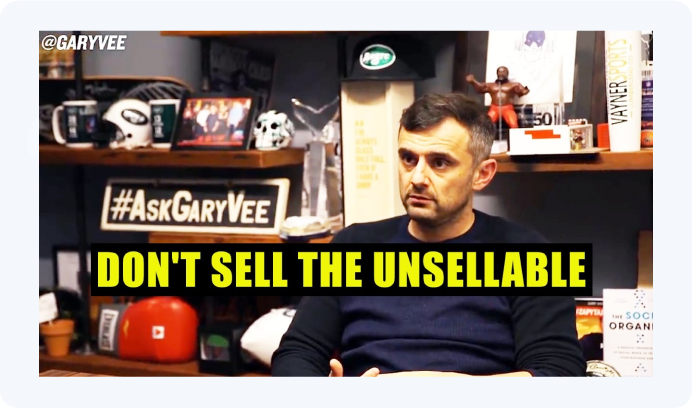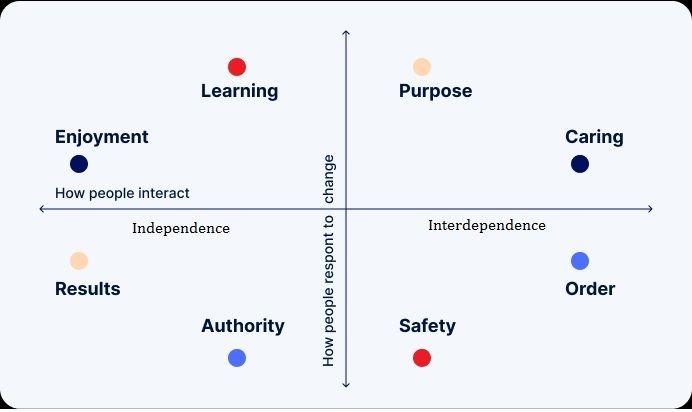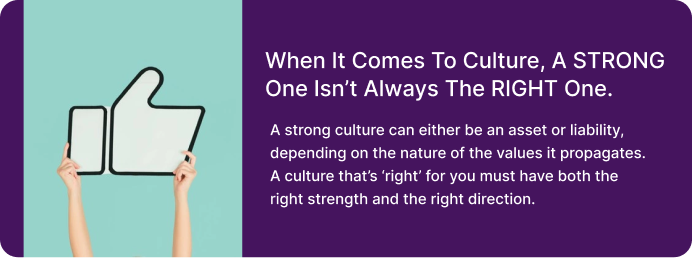What is Organizational Culture: The Gene of your Engine
What is organizational culture? It’s the shared values, behaviors, and interactions that define a workplace. A strong organizational culture fosters collaboration, drives performance, and shapes employee experiences, making it essential for business success.
On this page
- What is organizational culture?
- Definitions of organizational culture from different perspectives
- Spotting the spots: Characteristics of organizational culture
- The culture of subcultures
- HBR’s integrated culture framework
- Organizational design: The integrated culture framework approach
- What is the difference between culture and engagement?
- Impact of organizational culture on engagement
- The culture recipe: what goes into the design of a team’s culture?
- Rolling out your culture machine with values blueprinting
- Role of the employer in fostering a high-performance culture
- How do leaders control organizational culture (instead of being controlled by it)?
- Leaders building culture in their own image: An excerpt
- Empuls: The power of culture-driven engagement
- Culture is your GPS for the next normal
Culture, if you want to cut a long story short, is an organization’s HOW. How it works, how it transacts, how it hires. Organizational culture is what happens when nobody is looking.
It is “the accepted way of doing things” or the “appropriate way to make things happen” in that company. That said, organizational culture is often an offshoot of Why teams do what they do, What the organization does “for a living,” and whom the business serves through its products, services, and experiences.
A company derives its distinct identity from the way its people think, act, and behave, attributes that are directly influenced by its culture, which is why the origin of the word is important.
A company derives its distinct identity from the way its people think, act, and behave—attributes that are directly influenced by its culture. This is why understanding what is organizational culture is essential for businesses aiming to build a strong foundation.
Buckingham and Goodall observe that organizational culture is a watchword for where we want our company to go. Workplace culture has a profound impact on the end result of the work done by teams: desired business outcomes are usually determined by the coherence between strategy, operating model, and culture.
Culture lends an organization its distinct “personality” and “flavour,” and contributes to the unique social character and psychological temper we identify it with.
When two businesses interact, be it in the B2B marketplace or over the deal table—it is their respective cultures that stick out their respective necks first - nosing, scratching, and sniffing “each other out” (a lot of the time, without the corporate actors aware of it).
If a high five follows, it is usually because sensibilities - more than sense - have clicked at a deep, hidden level. Successful outfits know this and will often devote specialist trainers and resources to improve synergy in cross-cultural business interactions.
A team will often rise or fall by its culture—when it “clicks,” culture can unlock prodigious levels of tribe power—upending performance predictions by turning 2 + 2 into 10 and turning every step of the journey into a thrilling, memorable experience.
In the wrong hands, culture will turn even passionate people off their jobs, and send business vitals into a tailspin, often all the way to the bottom.
What is organizational culture?
Organizations are increasingly defining their raison-d’etre through their culture manifestos. Linkedin calls itself a tribe, Google tomtoms its Ten Truths, and Netflix’s “Freedom with responsibility” is wildly popular on the internet.
Culture taglines: more powerful than brand punchlines?
Everyone’s curious about what organizational culture is, and for a good reason.

Despite widely varying opinions of what is organizational culture – ranging from the dismissive “Oh, it’s about beanbags and foosball tables” to the romanticized “Culture is the arts elevated to a set of beliefs” by Thomas Wolfe, one thing is for sure - everyone is curious about it and everyone wants to get a measure of it.
One reason for that is we are usually uncomfortable with what we don’t “get” or are not 100% confident of. The other reason, of course, is that understanding something lets us re/work it to our advantage.
The relationship between culture and the top brass of a commercial outfit often isn’t very different. It wants to get a “hang of the culture” so that it can control – or, at the very least, predict and influence - worker behavior.
Others have their own motives. Jobseekers want to understand the culture so that they can ‘fit in’. Clients want to know what the culture is so that they can decode unsaid signals and hidden gestures.
Fans need to know a company’s position on global warming, LGBT, and equality (various upshots of culture) before following the latter’s social media pages.
Definitions of organizational culture from different perspectives
Workplace culture as a term entered the public discourse sometime in the early 1980s. In the early days, the connotation drew curiosity and debate primarily from (staff) managers, academics, and sociologists.
Today, it is everywhere. Documented literature on the topic is enormous, with multiple definitions, processes, and models doing their rounds.
Despite the long evolutionary curve, however, workplace culture remains an overused and frequently misunderstood term.
Here are some perspectives that attempt to capture its truth. Feel free to run with your favorite.
Let us now understand what is organizational culture from different perspectives:
1. Culture is who you are.
Culture is deeply coded into the psychological fabric of a team. It’s a combination of its inner personality (one revealed only to the mirror) and the persona that engages with the outside world.
You can think of it as the unwritten social order of an organization - the way it structures, positions, and carries or “behaves” itself, both with respect to employees and internal team members (a dimension referred to as “workplace culture”), as well as with the external ecosystem of customers, associates, partners, investors and stakeholders (a dimension known by the term ‘corporate culture’).

2. Culture cannot be copy-pasted.
Two teams or companies can have the same strategy (which, incidentally, is the other ‘power lever,’ along with culture, available to an organization’s leadership for boosting competitive edge), but not the same culture.
Just like every human possesses a unique fingerprint, every organization’s culture is it's very own – a signature that can be fudged but never quite replicated.
In a landscape of uncertainty and a sea of me-too competition, a thoughtfully modeled, reinforced, and rewarded culture is an unassailable edge for teams and their surest compass for navigating the choppy waters of change.
A big reason why it isn’t wise to try traditional culture index surveys or vendor/market benchmarks to understand or measure one’s culture.

3. Culture can only be (six) sensed.
For something that exists in unspoken rules and rites, culture is surprisingly loud, clear, and evident in the emotions and experiences that criss-cross a workplace in the course of an average day.
It will show up in the warmth you feel like a customer, the welcome that greets you as a new joiner, the sensitive candor you get as a client, and the regard you receive as a vendor, blue-collar associate, or channel partner. A lot of companies even develop cross functional team approach to breed culture.
That’s because, unlike its furniture or IPR, culture is that asset of a business that connects at a level and language we can understand.
4. Culture cannot be force-fitted.
Yes, you can integrate various programs within your workflows that nudge and encourage employees to experience your culture better and participate in it more readily.
Yes, you can set in place various tests and methods to calibrate and refine it. But no, you cannot force culture into the psyche of your workers.
Not only will that go against the very grain of the concept, but it will give you a false sense of the pulse of your people.
There are ways to handle a situation where your employees are not syncing with your culture code – such as introspection, open dialogue, and, lastly, parting ways.
Whatever you do, do NOT change your culture - that’s akin to selling out – or try to convince people about it if you think it’s unsellable. Just move on.

Spotting the spots: Characteristics of organizational culture
Culture is evident in the little and big habits, behaviors, rituals, customs, norms, traditions, artifacts, voice, symbolisms, and incentive-reward systems that team members practice as ‘second nature’ (that is, instinctively and reflexively, without conscious planning) day in, day out.
Right from the mission statement on the brochure to boss-worker relationships, the levels of transparency maintained with shareholders, the way conflict is resolved, how feedback is shared, the marketing roadmap, the emphasis on continuous learning+un/re-learning, the way achievements, birthdays, and new joinings are celebrated, the mindset that guides incentive and rewards, and the hiring and firing policy, nearly every aspect of an outfit is driven, directly or indirectly by its culture.
1. Culture cannot be faked.
An organization either has (a certain kind of) culture, or it doesn’t. Culture cannot be turned off or on at will. Your teams, for instance, cannot ‘glow with a certain vibe’ for four days of the week and switch mode for the other three.
At its finest, culture is implicit and subliminal, hardcoded into the psyche and instinct of people.
2. Culture is pervasive.
Culture is all-permeating. You cannot quarantine or culture-proof a specific department or role against the overall organizational culture. It flows right across space and teams, touching every nook and transforming every cranny.
Culture is universally shared. Your sales, research, and development (R&D), and café crew must all “tango to the same tune.”
3. Culture is a long-haul game.
Culture will take time to take root and usually demands strategic intervention and patient support along the way. Like a flywheel, the more rigorously you endorse, practice, and evangelize your organizational culture, the stronger it becomes.
4. Culture is enduring.
While it can help us negotiate flux, it is essential to note that culture does not change easily. It is, by definition, rooted in subconscious routines. You cannot ‘undo’ it at will, so be prudent in the way you embed it.
5. Culture is dynamic.
Culture may be hard to change, but not impossible. Indeed, its true powers are never more evident than when companies need to revamp and reimagine themselves (without losing core moorings), such as during the crisis precipitated by COVID-19.
Organizations who have been investing time and resources in building a cultural framework that is dynamic, flexible, and responsive to an external stimulus will now have their efforts bear fruit.
As MIT professor Edgar Schein notes “Culture is dynamic, in that it can evolve with new experiences. This change can happen in two ways: as the result of a clear and present crisis or through a managed evolution under a skilled and sophisticated manager.”
Firms like McKinsey are tackling the new world by reimagining processes, introducing more experts into the solution experience, redefining the aspirations of its markets and audiences, and fine-tuning risk management – an initiative they call Managed Evolution.
Aspects of culture
1. Degree of hierarchy: A deep respect for tradition, structure, authority, and rules lie at one end of this spectrum. On the other, we have flexibility and experimentation, where power is more decentralized, and people are encouraged to challenge convention. High, moderate, or low - where an organization lies along this continuum is a function of its culture, and vice versa.
2. Degree of urgency: At one extreme of this scale lie companies who like to make decisions fast, push through projects quickly, and exhibit a high level of agility to change. On the other end, you have more cautious and detail-oriented teams, giving precedence to consensus, consideration, and consistency.
3. Task-first vs people-first: This is again a ‘trade-off’ between two opposing assumptions. The first one believes that the human aspect is paramount in any business and puts people first when it comes to performance and productivity decisions. The second one places efficiency and outcomes at the top, and people are interpreted more as an ‘instrument or means, to the end’.
4. Function orientation: This relates to the functional areas that dominate an organization’s approach - such as R&D, operations, marketing, etc. A company will prioritize a function depending on its goals, historical inclinations, and society’s perception of its brand.
The culture of subcultures
Culture will often spawn sub-cultures within internal pockets and divisions. These are composed of tribes or employees who practice their signature norms and rules.
These rituals may not map directly and overtly to the organization's dominant culture, but a closer inspection will reveal that they are fundamentally moored in culture.
A company's subcultures can be informed by region, markets, or leadership charisma and are a fascinating study in re-imagination driven by necessity, creativity, or habit.
Firms like McKinsey leverage this intelligently and focus on building subculture synergy through teams.
Employees participate spontaneously and creatively to build micro-cultures for their teams, which manifests in how they conduct meetings, collaborate on workload, take decisions, share feedback, and respect individual styles.
The result is greater levels of efficiency, innovation, and impact.
HBR’s integrated culture framework
Boris Groysberg, Jeremiah Lee, Jesse Price, and J. Yo-Jud Cheng propose two primary dimensions of culture that apply regardless of organization type, size, industry, or geography:
A) People dynamic: Independence vs. interdependence.
B) Chance attitude: Flexibility vs. stability.
The above can be represented by a simple 2X2 graph referred to as an integrated culture framework.

Boris, Jeremiah, Jesse, and Cheng also offer eight different ‘styles’ – which fit into the integrated culture framework according to the degree to which they reflect the two dimensions - people interactions and response to change.
Let’s take a look at the eight styles:
1. Caring: Key focus areas are trust, collaboration, relationships, teamwork, and positivity. People look after each other and are united by empathy.
2. Purpose: The key focus is a noble, often “larger than life,” cause that goes beyond every day and the transactional and prioritizes the betterment of the community.
3. Learning: The key focus is curiosity, innovation, and discovery. Outcomes are often a function of repeated exploration, creativity, and serendipity.
4. Enjoyment: The key focus is playfulness, stimulation, and spontaneity and folks are encouraged to do what makes them happy.
5. Results: The key focus is results, the achievement is glorified, and workers are driven to deliver on KPI’s.
6. Authority: The key focus is power and confidence. Everyone aims to become an authority figure and dominate the competition.
7. Safety: The key focus is watchfulness, caution, and preparedness. Teams hedge against risks, prioritize stability, and prefer to plan realistically.
8. Order: The key focus is method, respect, and shared norms. Employees play by the rules, follow structure, and stick to legacy customs.
Organizational design: The integrated culture framework approach
For organization and workplace designers who must ensure that the forces of culture flow uninterrupted, it is crucial to understand the interplay of the above eight styles, and where they fall on the framework map.
Proximate styles such as safety and order, tend to co-exist more easily than those distanced from each other in spirits, such as authority and purpose.
While some organizations will experiment by mixing disparate style elements like safety and learning, it is an approach that must be handled with judiciousness because it runs the risk of confusing employees.
At its core, culture must have a single, unambiguous focus that is easy for workers to understand and practice and which isn’t dependent on variables, clauses, and conditions.
Is culture a skill you can acquire?
We tend to think of culture as a group thing. Something that’s in our DNA. Destined to ignite when people with a similar thing are put in the same room.
However, in his bestselling book “The Culture Code,” Daniel Coyle offers a different perspective. Having visited and researched eight of the world’s most successful groups, including a special ops military unit, an inner-city school, a professional basketball team, a movie studio, a comedy troupe, and a gang of jewel thieves, Coyle says, “I found that their cultures are created by a specific set of skills.”
Daniel Coyle's 3 culture skills:
- Skill 1: Building safety
- Skill 2: Sharing vulnerability
- Skill 3: Establishing purpose
According to Doyle, these three skills work in tandem ground up, first building group connection and then channelizing it into action.
What is the difference between culture and engagement?
Sorting an old riddle.
We continue to get culture and engagement mixed up, interchanging them glibly on zoom conversations, and measuring one when we should be tracking the other. To be fair, the confusion is understandable.
Most literature, talk shows, and media tend to use culture and engagement in the same breath, which is both puzzling and sad. Puzzling because it betrays an incomprehensible lack of vision and intent on the part of leaders to understand the two concepts that profoundly impact business outcomes.
Sad, because having more clarity can lead to far more profitable decisions and happier teams. So let's try to separate oil from what-looks-like-oil, one more time - shall we?
Impact of organizational culture on engagement
Culture and engagement are closely related yet conceptually distinct entities. When culture lays down the context for the business journey and the template for accepted behavioral rituals at work, it becomes easier for employees and workers to understand what they are working towards and what is expected from them.
While culture introduces the rules of the game, engagement proves whether your folks are enjoying the sport.
When workers approve of your cultural stance, they identify with your business objectives more readily, get involved in your journey more spontaneously and derive greater job satisfaction from every assignment and task. A classic picture of high engagement, leading to higher morale, boosted productivity, and greater value delivery to clients, partners, and fans.
The culture recipe: what goes into the design of a team’s culture?
Culture is the result of not one or two but several elements. It is distilled some of the history, vision, beliefs, values, and assumptions shared by every crew member of the ship.
Shared assumptions
Some of the big assumptions that guide an organization’s perception of its culture are:
- The company’s relationship vis-a-vis its environment: What does the business stand for? How do its products and services impact the community? What are the social goals it serves?
- Human nature: Are employees (read humans) inherently proactive or reactive? Are they self-centered or empathetic? Are they driven by monetary or non-monetary motivations?
- Emotional dynamics: What are the emotions that should be championed at the workplace? What are the mindsets that must be overpowered/overcome?
Shared values
Out of the several factors mentioned, shared values are the strongest pillars around which an organization’s culture superstructure is built. Some common focus points for value orientations are:
1. People: Welfare and empowerment of individuals and teams take precedence. Fairness, D&I (diversity and inclusivity), opportunities to grow, and fun at work go hand in hand.
2. Outcomes: Performance, achievement, and impact are what matter in this organization. All effort is optimized for the “End,” which, at times, will justify the “Means.”
3. Psychological safety: A mental safety net that allows people to take risks and use creativity at work by assuring members that they won’t be punished for speaking their minds.
4. Innovation: This is all about staying ahead of the curve, setting trends, and delighting customers with novel experiences. Radical creativity and against-the-grain thinking are prized.
5. Empathy: Sensitivity and consideration – be it to the markets, the community, or the environment - are prime influencers. Nothing charges up this team as “Let’s change the world.”
6. Integrity: Traits like trust, transparency, and accountability lead thought and action across rank and role. Commitment, respect, and responsibility tend to be natural by-products.
7. Teamwork: The catchwords here are synergy and collaboration. Regular cross-departmental workshops and cross-functional training ensure members have a view of situations from the perspectives of their peers – apart from their own. These companies are living proof that there is, indeed, strength in numbers.
8. Risk: Points to the organizational appetite for following its gut and intuition and how effortlessly it can take leaps of faith. The flip side is a premium on stability, safety, and consistency.
9. Aggression: It’s related to the competitiveness of an organization and its tendency to outperform rivals and dominate the domain. Coercion is no stranger to the equation, and some will resort to it readily.
10. Attention to detail: These organizations evangelize and promote perfectionism in their workers and pride themselves on differentiated products and experiences that cross every ‘i’ and tick every box.
11. Align or die: The big idea behind institutionalizing culture for the workplace is not to impress the fans and markets but to connect the organization's thoughts, actions, and decision-making seamlessly with its fundamental values, giving it the best chances of survival in a VUCA world.
Other ingredients in the culture recipe
Other factors, too, play a role in sculpting the final silhouette of a company’s culture. Business climate, economic trends, nationality, company size, the nature of the product/experience, and the industry or niche - all leave their distinct impact on the overall culture of an outfit.
Finally, it must be kept in mind that culture is actively upheld at all times by a bunch of “culture bearers,” of which the top leadership plays the lead.
Rolling out your culture machine with values blueprinting
Culture is formally set in motion through a process called ‘values blueprinting’ - an exercise where every stakeholder, particularly the leadership and heads of various groups and departments, sits across the table to thrash out nuances and aspects of the kind of culture they want for their organization.
To be genuinely authentic, an organization must be mindful to keep its behaviors and activities aligned to its core values. Therefore, a committee may be formed to ensure the letter and spirit are maintained and the leadership periodically informed on the status and health of its culture.
Role of the employer in fostering a high-performance culture
You cannot prevent culture from evolving in your workplace: It is an ‘autonomous phenomenon’ that will find a place to plant itself and branch out in every direction, whether you like it or not.
You do, however, get to choose whether what’s growing under your nose is fungus or flower.

Aware bosses and alert entrepreneurs know this too well and keep a close tab on their culture (an approach referred to as top-down implementation) - guiding and shepherding it along, so it doesn’t go off the rails.
Instead of regarding organizational culture as an unwieldy source of frustration, they treat it like a strategic management tool that’s worth investing time to understand.
These individuals know that the best way to “transfer the spark” is to walk the talk and act the role. When it comes to culture, acting is essential but acting visibly is more critical. Healthy cultures start with the commitment of the CEO.
As Ann Rhoades, co-founder of JetBlue, former Chief People Officer of Southwest Airlines and Promus Hotel Company, noted,
“You have to show people what the values are, starting at the top, through your behavior. You cannot define behaviours for everyone but the CEO.”
These leaders are proactive personalities who make sure that their culture is relevant to the current time and responsive to new realities and opportunities - while ensuring that it stays honest to the grand purpose.
How do leaders control organizational culture (instead of being controlled by it)?
They do this by continuously tweaking and re/engineering the daily interplay of behaviors and attitudes at work – with tact and sensitivity.
These personalities will:
- Take a personal interest in hiring and role fitment.
- Ensure acclimatization for new hires by experiential demos and the seamless transfer of culture tenets.
- Create a culture-empowered work environment that incentivizes involvement and rewards achievement.
- Make room for regular re/training sessions.
- Hold employees accountable for both wins and losses.
- Root passionately for the ‘common spirit’ on slack/intranet channels and social/online platforms.
Bold leadership, open communication, and meaningful delegation are three pillars at a leader or manager’s disposal to boot up their “own version” of culture.
A great leader will lay out the culture vision in clear and straightforward language, demonstrate it by walking the talk at every turn, and sidestep micro-management by trusting their teams to uphold the mojo.
Receptive and intuitive supervisors blend their intentions with the knowledge and wisdom of frontline folks to create a more refined and robust experience.
Do note: Intervention from the top, while a laudable essential, can be a double-edged sword. Leaders with strong personalities and exceptional charisma can leave a lasting personal legacy – be it consciously or subconsciously - on the organization’s culture. Often, but not always, for the better.
Leaders building culture in their own image: An excerpt
Bob Page felt like an outsider and had to hide his sexuality. When he built Replacements, Ltd., he ensured it would be a place that accepted diversity—not just of lifestyle but of thought—and would invest in building their community.
Anita Roddick founded "The Body Shop" to build an environmentally-friendly corporation, which reflected her commitment to environmental activism.
Jim Goodnight's commitment to work-life balance is part of the culture at SAS, the largest privately-held company in the world. Jack Welch's commitment to being the best created an environment of excellence at General Electric. In each of these cases, the ethics of the leader became a central part of the culture.
Empuls: The power of culture-driven engagement
A company’s success isn’t just built on strategies and profits—it thrives on the strength of its organizational culture. Culture shapes how employees collaborate, communicate, and feel about their work environment. It’s not just about workplace policies but the daily interactions that define the employee experience. For organizations looking to strengthen their culture, Empuls provides the right tools to turn values into actions.

A well-defined organizational culture fosters engagement, enhances motivation, and builds a sense of belonging. But culture isn’t something that happens naturally—it requires continuous effort and alignment. Empuls, an advanced company culture software, helps organizations nurture and sustain a culture that promotes productivity, recognition, and employee well-being.
✔ Builds a culture of recognition – Encourages peer-to-peer and leadership-driven recognition to make employees feel valued and appreciated for their contributions.
✔ Encourages open communication – The social intranet feature strengthens workplace connections, fostering transparency and collaboration across teams.
✔ Gathers real-time employee insights – Pulse surveys and engagement analytics help organizations measure culture and make data-backed improvements.
✔ Enhances employee motivation – Structured rewards and incentives keep employees engaged, ensuring that contributions don’t go unnoticed.
✔ Creates a connected workforce – Empuls promotes inclusivity by giving employees a voice, making culture a shared responsibility rather than just a leadership-driven initiative.
A strong organizational culture isn’t just about mission statements—it’s about fostering an environment where employees feel connected, motivated, and aligned with company goals. With Empuls, organizations can build, sustain, and continuously improve a culture that drives long-term success.
Culture is your GPS for the next normal
As organizations figure out ways to deal with a new normal, culture offers them a handy pivot.
As Goodall and Buckingham put it: “Beyond explaining the now, culture has become our handle on the next.”
Culture custodians must now identify, separate, and accelerate behaviors (embedded in their culture) that can help them build the kind of edge they need in a new reality - while neutering attitudes that can cause headwinds - to reboot sustainable competitive advantage.


















